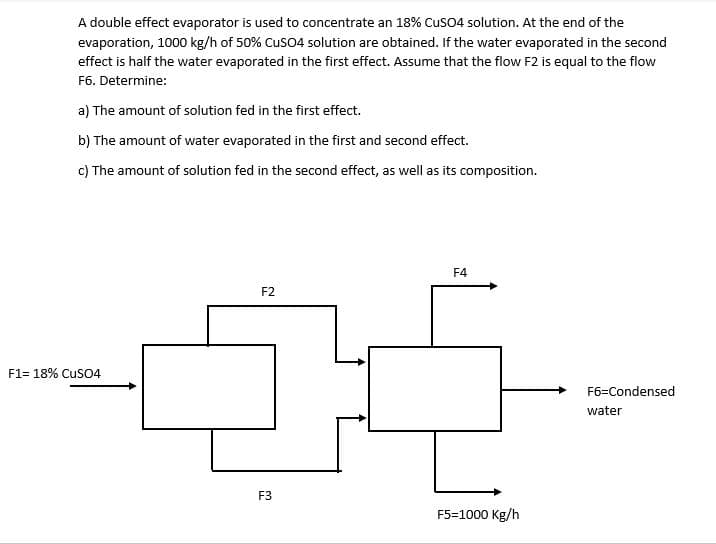A double effect evaporator is used to concentrate an 18% CuSO4 solution. At the end of the evaporation, 1000 kg/h of 50% CuSO4 solution are obtained. If the water evaporated in the second effect is half the water evaporated in the first effect. Assume that the flow F2 is equal to the flow F6. Determine: a) The amount of solution fed in the first effect. b) The amount of water evaporated in the first and second effect. c) The amount of solution fed in the second effect, as well as its composition. F1 = 18% CUSO4 F2 F3 F4 F5=1000 kg/h F6-Condensed water
A double effect evaporator is used to concentrate an 18% CuSO4 solution. At the end of the evaporation, 1000 kg/h of 50% CuSO4 solution are obtained. If the water evaporated in the second effect is half the water evaporated in the first effect. Assume that the flow F2 is equal to the flow F6. Determine: a) The amount of solution fed in the first effect. b) The amount of water evaporated in the first and second effect. c) The amount of solution fed in the second effect, as well as its composition. F1 = 18% CUSO4 F2 F3 F4 F5=1000 kg/h F6-Condensed water
Introduction to Chemical Engineering Thermodynamics
8th Edition
ISBN:9781259696527
Author:J.M. Smith Termodinamica en ingenieria quimica, Hendrick C Van Ness, Michael Abbott, Mark Swihart
Publisher:J.M. Smith Termodinamica en ingenieria quimica, Hendrick C Van Ness, Michael Abbott, Mark Swihart
Chapter1: Introduction
Section: Chapter Questions
Problem 1.1P
Related questions
Question
100%

Transcribed Image Text:A double effect evaporator is used to concentrate an 18% CuSO4 solution. At the end of the
evaporation, 1000 kg/h of 50% CuSO4 solution are obtained. If the water evaporated in the second
effect is half the water evaporated in the first effect. Assume that the flow F2 is equal to the flow
F6. Determine:
a) The amount of solution fed in the first effect.
b) The amount of water evaporated in the first and second effect.
c) The amount of solution fed in the second effect, as well as its composition.
F1= 18% CuSO4
F2
F3
F4
F5=1000 Kg/h
F6-Condensed
water
Expert Solution
This question has been solved!
Explore an expertly crafted, step-by-step solution for a thorough understanding of key concepts.
This is a popular solution!
Trending now
This is a popular solution!
Step by step
Solved in 5 steps with 1 images

Recommended textbooks for you

Introduction to Chemical Engineering Thermodynami…
Chemical Engineering
ISBN:
9781259696527
Author:
J.M. Smith Termodinamica en ingenieria quimica, Hendrick C Van Ness, Michael Abbott, Mark Swihart
Publisher:
McGraw-Hill Education

Elementary Principles of Chemical Processes, Bind…
Chemical Engineering
ISBN:
9781118431221
Author:
Richard M. Felder, Ronald W. Rousseau, Lisa G. Bullard
Publisher:
WILEY

Elements of Chemical Reaction Engineering (5th Ed…
Chemical Engineering
ISBN:
9780133887518
Author:
H. Scott Fogler
Publisher:
Prentice Hall

Introduction to Chemical Engineering Thermodynami…
Chemical Engineering
ISBN:
9781259696527
Author:
J.M. Smith Termodinamica en ingenieria quimica, Hendrick C Van Ness, Michael Abbott, Mark Swihart
Publisher:
McGraw-Hill Education

Elementary Principles of Chemical Processes, Bind…
Chemical Engineering
ISBN:
9781118431221
Author:
Richard M. Felder, Ronald W. Rousseau, Lisa G. Bullard
Publisher:
WILEY

Elements of Chemical Reaction Engineering (5th Ed…
Chemical Engineering
ISBN:
9780133887518
Author:
H. Scott Fogler
Publisher:
Prentice Hall


Industrial Plastics: Theory and Applications
Chemical Engineering
ISBN:
9781285061238
Author:
Lokensgard, Erik
Publisher:
Delmar Cengage Learning

Unit Operations of Chemical Engineering
Chemical Engineering
ISBN:
9780072848236
Author:
Warren McCabe, Julian C. Smith, Peter Harriott
Publisher:
McGraw-Hill Companies, The